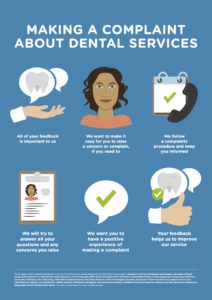Competing
Practice owners and managers worry about practices ‘down the road’ and what they are doing. What they are advertising, what their fees are, the list goes on.
I always stress that in most cases patients are not deciding between practices to go to they are deciding to choose Dentistry or a holiday, a deposit on a car, Christmas. Other purchases that are as equally important to them.
The most dangerous place to be in business is in a position of competition with another dental practice.
In my opinion if you know who you want to attract as patients’, who you are as a buisness, who you are there to service, if you have the right brand message and the team that deliver, then you do not need to look at other practices and compete against them. In fact they may be looking at you.
Laura

Our opinion on complaint handling best practice, the six core principles
When I am working with a practice on their patient experience, handling complaints can be on the agenda. Unfortunately sometimes dealing with rude and abusive patients is on the agenda too.
This week the “six core principles for handling complaints” has been released. This is a joint initiative by 28 organisations in Dentistry to support complaint handling in practice with the aim of reducing patients going directly to the General Dental Council.
When dealing with a disgruntled patient I always advise that the team listen, use positive body language and encourage the patient to use the practice’s complaints procedure – this can worry practice owners and managers as complaints are seen as a negative. To me they can be really positive as they may:
- Stop the patient complaining and put an end to the conversation
- Stop tit for tat conversation “yes we cancelled you but you have been late five times”
- Allow the patient to calm down
- Allow the practice to investigate and most often confirm that your systems work for you (that’s great) or you learn that you need a new system or an amendment to a system and team training
- Demonstrate to the patient and all patients listening that you are not worried about a complaint and will instead not take whinging and moaning from patients.
For me, there are three categories of complaint:
Minor – parking issues, roadworks and the clinician running up to five minutes late.
Medium – Running over five minutes late, cancelling patients, charging a patient for an FTA, failed treatment, unhappy outcome from treatment.
Major – GDC, CQC, legal letter.
All of the minor and medium complaints need to be logged regardless of a patient making a formal complaint.
I agree with the recommendations in the poster but do want to stress that the team do need to be trained on how to handle a complaint and they must know the complaints procedure so that they can communicate it with ease.
For more information and to download the poster and leaflets click here
Laura

The little things that get patients worried
Yesterday morning I took my son to my gym to use the swimming pool, my son currently has a fascination with clocks. So as we were changing he pointed out the clock in the changing room. It was 09:30 but the clock displayed 10:30. An hour later as we left the clock still had not been changed.
I had like many others, changed the time of all of our house clocks and my car by 8am. I have to have the right time displayed.
This morning I went to the gym and the clock in the changing room still had not been changed, nor had any other of the clocks around the gym. The digital clock on display in areas had been changed, but it was probably linked to a server and updated automatically.
On Saturday at the gym the wipes for cleaning machinery were out, they were still out this morning.
This tells me that no-one checks a thing in this gym, no-one is responsible for setting standards and checking things, that then leads me to think that no-one probably cleans the place! I wouldn’t know 100% about that as I have only been there two months, and as I go early have never seen a staff member on the gym floor, they are all at the desk moaning every morning (a blog for another time).
So if right now in your practice you haven’t changed your clocks, I can honestly say that your patients’ will start to wonder what else might be wrong, what else are you not doing? Imagine if Big Ben did not have the correct time displayed, it might make front page news.
It is the little things that set patients’ off:
- Instruments out ready for use when they enter the room
- Gloves already on
- Loops being worn with no explanation of their USP
No patient wants to think that the instruments have been used on the patient before them, the same gloves are being worn and the hands have not been washed, and finally that the clinician hasn’t got good eye sight.
Show off your excellence and communicate it well, don’t let a little thing such as the time being wrong put concerns into peoples minds.
And finally to add I have complained about the wipes on my way out but not the clocks, I am waiting to see what will happen there.
Laura

Tracking is motivational
I have had a summer of getting back on it.
I had knee surgery in February and although I initially recovered quickly, I hadn’t realised that actually progress was slow and that my level of exercise and diet were not matching up. I found after a few months that my favourite clothes were not feeling comfortable so it was time for action. I talked to my personnel trainer about my concerns and he suggested I use My Fitness Pal to track my calories. Now, I love food so I needed a long term sustainable plan. We planned my amount of calories for each day and discussed how I can invest them in whatever I want but that I need to track what I am putting into my body.
Tracking on a daily basis has become a way of life over the last few months and now I have been doing it I am seeing results. My Fitness Pal shows me the results every day, every week and then every month. I am motivated to continue tracking daily as it shows me that what I am doing every day is working, even when I have a bad day.
 For me this model of tracking is the same as new patient tracking. I like practices to track new patients’, as it shows how a practice is doing at every stage of conversion and this is so important to the continued success of dental businesses. The conversion points in a dental practice encompass the following:
For me this model of tracking is the same as new patient tracking. I like practices to track new patients’, as it shows how a practice is doing at every stage of conversion and this is so important to the continued success of dental businesses. The conversion points in a dental practice encompass the following:
- Entry point – website, social media, advert etc
- Telephone or online enquiry
- Reception response to telephone / online enquiry
- Treatment coordinator input
- Comprehensive assessment
- Options
- Follow up from options meeting
- Treatment plan
- Tracking of all treatment in treatment plan
- End of treatment plan
- Membership ongoing care
This is a huge patient experience and the conversion points need to be tracked for each aspect, daily, weekly and monthly. Each member of the team can influence the conversion from continuing and I often uncover many breaks in the conversion in practices, in each point listed above.
One of the main areas practices concentrate on is the starting point. This is a very important part naturally, as it also confirms if your investment in marketing is working, however you must place the same emphasis on all the other points of the new patient experience.
I often see a breakdown at points 7 through to point 9. This is where the practice need to invest more in making sure that patients follow through with all the recommended treatment, it still amazes me how often this area is not tracked at all. A month later when it is quiet the reception team are asked to run an outstanding treatment report and start calling patients, which is not always too effective in my opinion it is often too late.
First and foremost you meed to invest time in tracking the 11 points, once you have set this up then you can look at areas that need training and support to get your conversion % at each point to a higher level. Remember 1-2% increase in this model delivers a lot of additional cash flow in your business, so this really is worth tracking every day. Tracking has got me back on track and gets my coaching clients on track to. Remember not every day is a good day, things happen but if you are not tracking how do you know if you are having a good to a bad day?
Be motivated and start tracking today as it is the key to success.
Michael

